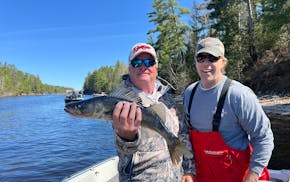Temperate fall weather, with cloudy skies and highs forecast in the low 50s throughout much of the state, will greet Minnesota hunters statewide Saturday when the 2024 firearms deer season begins.
Weather on opening weekend plays a major role in determining the state's seasonal whitetail harvest, because a significant number of hunters are afield only on those days.
The state Department of Natural Resources is expecting a total deer harvest this fall comparable to last year's 158,678. That number was an 8% falloff from 2022 and 14% less than the five-year average.
The DNR significantly reduced the number of antlerless permits it issued this year by lottery, from 15,350 a year ago to 10,500. The DNR also increased by two, from nine to 11, the number of Deer Permit Areas (DPAs) this fall designated as bucks only. Both actions will result in less opportunity for hunters to kill deer compared to 2023.
DNR Big Game Program Leader Barb Keller believes the cutbacks could be countered by a slight (1%) increase in license sales so far, as well as indications that the archery deer harvest is picking up after a slow start, probably because of unseasonably warm weather.
"Also, youth season and early antlerless harvests were up slightly compared to last year," Keller said in an email to the Minnesota Star Tribune. "And the corn harvest is mostly complete so hunters in the farmland region should have a good chance at spotting deer."
Keller also said she is "slightly optimistic" about the firearms deer harvest in northeast Minnesota where — because of extreme winter weather, predation by wolves and loss of habitat — whitetail numbers have been depressed.
"We likely need several mild winters to really turn the dial on northern deer populations," Keller said.
The recent mild winter should have encouraged fawn production in spring, Keller said, resulting in a boost of the state's deer population. She noted, however, that according to a DNR study in southwest Minnesota, the fawn survival rate to three months of age was only 36% because of rain and coyote predation. That survival rate might be an outlier, Keller cautioned, compared to other areas in the state.

Anderson: In early June, Minnesota fish are begging to be caught. Won't you help?

Anderson: Tails wagging, DNR officers' dogs find lost people and missing evidence
Anderson: Punish poachers more
Anderson: The Chainsaw Sisters Saloon is gone, but the Echo Trail is still a pathway to possibilities


